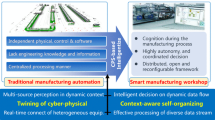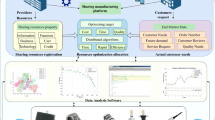Abstract
The increasing personalized product demands bring reformation to the manufacturing paradigm. Traditional manufacturing systems seldom analyze and give feedback on the data collected during production. The bottleneck between the physical and digital worlds of manufacturing systems is the lack of interoperability. In this paper, a digital twin-based self-organizing manufacturing system (DT-SOMS) is presented under the individualization paradigm. On the basis of the interconnection between smart workpieces and smart resources via decentralized digital twin models, a decentralized self-organizing network is established to achieve intelligent collaboration between tasks and resources. The mechanism of job-machine optimal assignment and adaptive optimization control is constructed to improve the capabilities of reconfiguration and responsiveness of the DT-SOMS. An implement case is designed to illustrate that the proposed DT-SOMS can realize synchronized online intelligence in the configuration of resources and response to disturbances.











Similar content being viewed by others
Data availability
The authors confirm that the data supporting the findings of this study are available within the article.
Code availability
Not applicable.
References
Zhou B, Bao J, Li J, Lu Y, Liu T, Zhang Q (2021) A novel knowledge graph-based optimization approach for resource allocation in discrete manufacturing workshops Robot. Comput-Integr Manuf 71:102160. https://doi.org/10.1016/j.rcim.2021.102160
Zhang Y, Zhu H, Tang D, Zhou T, Gui Y (2022) Dynamic job shop scheduling based on deep reinforcement learning for multi-agent manufacturing systems. Robot Comput-Integr Manuf 78:102412. https://doi.org/10.1016/j.rcim.2022.102412
Ding K, Chan FTS, Zhang X, Zhou G, Zhang F (2019) Defining a digital twin-based cyber-physical production system for autonomous manufacturing in smart shop floors. Int J Prod Res 57:6315–6334. https://doi.org/10.1080/00207543.2019.1566661
Kusiak A (2018) Smart manufacturing. Int J Prod Res 56:508–517. https://doi.org/10.1080/00207543.2017.1351644
Liu XF, Shahriar MR, Al Sunny SMN, Leu MC, Hu L (2017) Cyber-physical manufacturing cloud: architecture, virtualization, communication, and testbed. J Manuf Syst 43:352–364. https://doi.org/10.1016/j.jmsy.2017.04.004
Schleich B, Anwer N, Mathieu L, Wartzack S (2017) Sha** the digital twin for design and production engineering. CIRP Ann 66:141–144. https://doi.org/10.1016/j.cirp.2017.04.040
Valckenaers P, Van Brussel H, Holvoet T (2008) Fundamentals of holonic systems and their implications for self-adaptive and self-organizing systems. in: 2008 Second IEEE Int Conf Self-Adapt Self-Organ Syst Workshop, pp. 168–173. https://doi.org/10.1109/SASOW.2008.29
Leitão P, Restivo F (2006) ADACOR: A holonic architecture for agile and adaptive manufacturing control. Comput Ind 57:121–130. https://doi.org/10.1016/j.compind.2005.05.005
Colombo AW, Schoop R, Neubert R (2006) An agent-based intelligent control platform for industrial holonic manufacturing systems. IEEE Trans Ind Electron 53:322–337. https://doi.org/10.1109/TIE.2005.862210
Park H-S, Tran N-H (2012) An autonomous manufacturing system based on swarm of cognitive agents. J Manuf Syst 31:337–348. https://doi.org/10.1016/j.jmsy.2012.05.002
Liu C, Su Z, Xu X, Lu Y (2022) Service-oriented industrial internet of things gateway for cloud manufacturing. Robot Comput-Integr Manuf 73:102217. https://doi.org/10.1016/j.rcim.2021.102217
Barenji AV, Guo H, Wang Y, Li Z, Rong Y (2021) Toward blockchain and fog computing collaborative design and manufacturing platform: support customer view. Robot Comput-Integr Manuf 67:102043. https://doi.org/10.1016/j.rcim.2020.102043
Gamboa Quintanilla F, Cardin O, L’Anton A, Castagna P (2016) Virtual commissioning-based development and implementation of a service-oriented holonic control for retrofit manufacturing systems, in: T. Borangiu, D. Trentesaux, A. Thomas, D. McFarlane (Eds.), Serv. Orientat. Holonic Multi-Agent Manuf., Springer International Publishing, Cham, pp. 233–242. https://doi.org/10.1007/978-3-319-30337-6_22
Zhou T, Tang D, Zhu H, Zhang Z (2021) Multi-agent reinforcement learning for online scheduling in smart factories. Robot Comput-Integr Manuf 72:102202. https://doi.org/10.1016/j.rcim.2021.102202
Liu C, Zhu H, Tang D, Nie Q, Zhou T, Wang L, Song Y (2022) Probing an intelligent predictive maintenance approach with deep learning and augmented reality for machine tools in IoT-enabled manufacturing. Robot Comput-Integr Manuf 77:102357. https://doi.org/10.1016/j.rcim.2022.102357
Want R (2006) An introduction to RFID technology. IEEE Pervasive Comput 5:25–33. https://doi.org/10.1109/MPRV.2006.2
McFarlane D, Sarma S, Chirn JL, Wong CY, Ashton K (2003) Auto ID systems and intelligent manufacturing control. Eng Appl Artif Intell 16:365–376. https://doi.org/10.1016/S0952-1976(03)00077-0
Kortuem G, Kawsar F, Sundramoorthy V, Fitton D (2010) Smart objects as building blocks for the Internet of things. IEEE Internet Comput 14:44–51. https://doi.org/10.1109/MIC.2009.143
González García C, MeanaLlorián D, Pelayo G-Bustelo C, Cueva-Lovelle JM (2017) A review about smart objects, sensors, and actuators. Int J Interact Multimed Artif Intell 4:7. https://doi.org/10.9781/ijimai.2017.431
Rosen R, von Wichert G, Lo G, Bettenhausen KD (2015) About the importance of autonomy and digital twins for the future of manufacturing. IFAC-Pap 48:567–572. https://doi.org/10.1016/j.ifacol.2015.06.141
Ding K, Jiang P, Sun P, Wang C (2017) RFID-enabled physical object tracking in process flow based on an enhanced graphical deduction modeling method. IEEE Trans Syst Man Cybern Syst 47:3006–3018. https://doi.org/10.1109/TSMC.2016.2558104
Park H-S, Tran N-H (2011) An autonomous manufacturing system for adapting to disturbances. Int J Adv Manuf Technol 56:1159–1165. https://doi.org/10.1007/s00170-011-3229-2
Park JH, Yen NY (2018) Advanced algorithms and applications based on IoT for the smart devices. J Ambient Intell Humaniz Comput 9:1085–1087. https://doi.org/10.1007/s12652-018-0715-5
Lee J, Bagheri B, Kao H-A (2015) A Cyber-Physical Systems architecture for industry 4.0-based manufacturing systems. Manuf Lett 3:18–23. https://doi.org/10.1016/j.mfglet.2014.12.001
Wang F-Y (2010) The emergence of intelligent enterprises: from CPS to CPSS. IEEE Intell Syst 25:85–88. https://doi.org/10.1109/MIS.2010.104
Qin Z, Lu Y (2021) Self-organizing manufacturing network: a paradigm towards smart manufacturing in mass personalization. J Manuf Syst 60:35–47. https://doi.org/10.1016/j.jmsy.2021.04.016
Antons O, Arlinghaus JC (2022) Data-driven and autonomous manufacturing control in cyber-physical production systems. Comput Ind 141:103711. https://doi.org/10.1016/j.compind.2022.103711
Lu Y, Xu X (2018) Resource virtualization: A core technology for develo** cyber-physical production systems. J Manuf Syst 47:128–140. https://doi.org/10.1016/j.jmsy.2018.05.003
Vogt A, Müller RK, Kampa T, Stark R, Großmann D (2021) Concept and architecture for information exchange between digital twins of the product (CPS) and the production system (CPPS). Procedia CIRP 104:1292–1297. https://doi.org/10.1016/j.procir.2021.11.217
Ribeiro L, Björkman M (2018) Transitioning from standard automation solutions to cyber-physical production systems: an assessment of critical conceptual and technical challenges. IEEE Syst J 12:3816–3827. https://doi.org/10.1109/JSYST.2017.2771139
Müller T, Jazdi N, Schmidt J-P, Weyrich M (2021) Cyber-physical production systems: enhancement with a self-organized reconfiguration management. Procedia CIRP 99:549–554. https://doi.org/10.1016/j.procir.2021.03.075
Wang C, Jiang P, Ding K (2017) A hybrid-data-on-tag–enabled decentralized control system for flexible smart workpiece manufacturing shop floors. Proc Inst Mech Eng Part C J Mech Eng Sci 231:764–782. https://doi.org/10.1177/0954406215620452
Wan G, Dong X, Dong Q, He Y, Zeng P (2022) Context-aware scheduling and control architecture for cyber-physical production systems. J Manuf Syst 62:550–560. https://doi.org/10.1016/j.jmsy.2022.01.008
Okpoti ES, Jeong I-J (2021) A reactive decentralized coordination algorithm for event-driven production planning and control: a cyber-physical production system prototype case study. J Manuf Syst 58:143–158. https://doi.org/10.1016/j.jmsy.2020.11.002
Grieves M, Vickers J (2017) Digital twin: mitigating unpredictable, undesirable emergent behavior in complex systems, in: F.-J. Kahlen, S. Flumerfelt, A. Alves (Eds.), Transdiscipl. Perspect. Complex Syst. New Find. Approaches, Springer International Publishing, Cham, pp. 85–113. https://doi.org/10.1007/978-3-319-38756-7_4.
Glaessgen EH, Stargel DS (2012) The digital twin paradigm for future NASA and U.S. Air force vehicles. In: Collection of Technical Papers - AIAA/ASME/ASCE/AHS/ASC Structures, Structural Dynamics and Materials Conference. https://doi.org/10.2514/6.2012-1818
Tao F, Zhang M (2017) Digital twin shop-floor: a new shop-floor paradigm towards smart manufacturing. IEEE Access 5:20418–20427. https://doi.org/10.1109/ACCESS.2017.2756069
Alam KM, El Saddik A (2017) C2PS: a digital twin architecture reference model for the cloud-based cyber-physical systems. IEEE Access 5:2050–2062. https://doi.org/10.1109/ACCESS.2017.2657006
Bao J, Guo D, Li J, Zhang J (2019) The modelling and operations for the digital twin in the context of manufacturing. Enterp Inf Syst 13:534–556. https://doi.org/10.1080/17517575.2018.1526324
Liu K, Song L, Han W, Cui Y, Wang Y (2022) Time-varying error prediction and compensation for movement axis of CNC machine tool based on digital twin. IEEE Trans Ind Inform 18:109–118. https://doi.org/10.1109/TII.2021.3073649
Zhang K, Qu T, Zhou D, Jiang H, Lin Y, Li P, Guo H, Liu Y, Li C, Huang GQ (2020) Digital twin-based opti-state control method for a synchronized production operation system. Robot Comput-Integr Manuf 63:101892. https://doi.org/10.1016/j.rcim.2019.101892
Leng J, Liu Q, Ye S, **g J, Wang Y, Zhang C, Zhang D, Chen X (2020) Digital twin-driven rapid reconfiguration of the automated manufacturing system via an open architecture model. Robot Comput-Integr Manuf 63:101895. https://doi.org/10.1016/j.rcim.2019.101895
Zhang Z, Guan Z, Gong Y, Luo D, Yue L (2022) Improved multi-fidelity simulation-based optimisation: application in a digital twin shop floor. Int J Prod Res 60:1016–1035. https://doi.org/10.1080/00207543.2020.1849846
Nie Q, Tang D, Zhu H, Sun H (2021) A multi-agent and internet of things framework of digital twin for optimized manufacturing control. Int J Comput Integr Manuf 0:1–22. https://doi.org/10.1080/0951192X.2021.2004619
Wang G, Zhang G, Guo X, Zhang Y (2021) Digital twin-driven service model and optimal allocation of manufacturing resources in shared manufacturing. J Manuf Syst 59:165–179. https://doi.org/10.1016/j.jmsy.2021.02.008
Funding
This work was supported by the National Key Research and Development Program of China [grant number 2021YFB1716304], the National Natural Science Foundation of China [grant number 52075257], and the Key Research and Development Program of Jiangsu Province [No. BE2021091].
Author information
Authors and Affiliations
Corresponding author
Ethics declarations
Ethical approval
Not applicable.
Consent to participate
Not applicable.
Consent for publication
Not applicable.
Conflict of interest
The authors declare competing interests.
Additional information
Publisher's note
Springer Nature remains neutral with regard to jurisdictional claims in published maps and institutional affiliations.
Rights and permissions
Springer Nature or its licensor (e.g. a society or other partner) holds exclusive rights to this article under a publishing agreement with the author(s) or other rightsholder(s); author self-archiving of the accepted manuscript version of this article is solely governed by the terms of such publishing agreement and applicable law.
About this article
Cite this article
Song, J., Zhang, Z., Tang, D. et al. Designing and modeling of self-organizing manufacturing system in a digital twin shop floor. Int J Adv Manuf Technol 131, 5589–5605 (2024). https://doi.org/10.1007/s00170-023-10965-6
Received:
Accepted:
Published:
Issue Date:
DOI: https://doi.org/10.1007/s00170-023-10965-6




